If “April’s
showers brings May flowers”, then “July’s
sun makes August overdone.” I’m looking forward
to the start of the summer monsoon season to wash away the
heat of July. The air feels like an oven; I feel cooked.
Even the reptiles, those classic desert creatures, watch
me and the Englishmen and the mad dogs from beneath protective
shade.
Many people think of reptiles as able to withstand these searing temperatures,
going days without a drop of moisture. Though these snakes and lizards
are well adapted to the desert, they are not immune from the heat. Like
us, they tolerate these hot days, but you might find yourself alone if
you are looking for them during the middle of a hot day.
Early morning and late afternoon are good time periods to search for
lizards. The temperatures are warm enough for their insect prey to be
active, yet not too hot for the lizards themselves. Though most lizards
are insectivores, the colorful collared lizard and the spotted long-nosed
leopard lizard might be out hunting their smaller cousins.
Collared lizards, sporting their turquoise bodies and yellow heads, seem
hard to overlook, especially when they are perched atop some rocky outcrop
or boulder, scanning the neighborhood for prey and predators. One might
think that their coloration is a bad idea, but it makes them visible
to other collared lizards. The color is a good idea during mating season
or when defending their territories through visual displays. Unfortunately,
certain predators like redtails and ferruginous hawks can also spot these
colors from a distance. As one would guess, the life span of a collared
lizard is not all that long.
The long-nosed leopard lizard seems to blend into its surroundings better
than the collared lizard. Their spotting pattern makes them difficult
to see against the sandy ground, except for when they move. Like the
collared lizard, the longnosed is also a large lizard.
Besides the hawks, these two lizards have to be aware of other predators
like foxes, coyotes, and snakes. Bull snakes, sometimes reaching four
feet in length, might go after one of these lizards. Unlike rattlesnakes,
which inject venom into their prey, bull snakes are constrictors, killing
their prey in a reptilian embrace. A good place to look for bull snakes
is the Arches National Park road during the evening. While out searching
for prey, sometimes these snakes utilize the warm pavement to maintain
their body heat.
Of the smaller lizards, the side-blotched and the tree lizard are two
common ones that hikers might encounter. The side-blotched is named for
the dark spots behind their forelegs, while the tree lizard might be
seen climbing a tree trunk in search of prey. Mostly, I see them on the
ground or traversing across a rock face. Maybe they are enroute to the
trees.
These lizards feed upon ants, beetles, flying insects, and moths. Because
of their small size, it does not take these creatures long to warm up
or overheat. Later in the season, when there is a hint of autumn in the
air, the larger lizards might be thinking of hibernation, but these two
species are still active. In fact, I’ve seen side-blotched lizards
scurrying about on warm December days.
In places like the Cisco Desert, where you might find all these reptiles,
the side-blotched and tree lizard might fall prey to a burrowing owl.
Though these small diurnal owls feed on mice, grasshoppers, and beetles,
they do select an unsuspecting lizard for themselves or their fledglings.
So even though these reptiles have to content with desert temperatures
and predators, their track record through time is impressive. I could
ask them if they too feel cooked by summer’s sun, but I’m
sure they would pay me little attention. They have more important matters
on their plates and palettes.
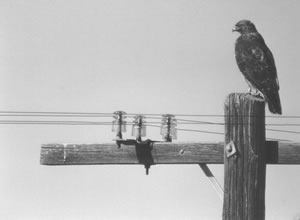
|
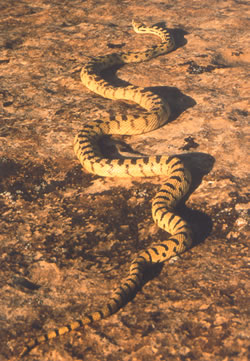
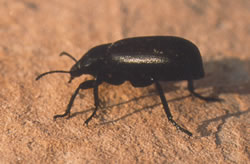


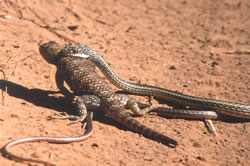
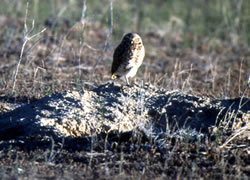
|







